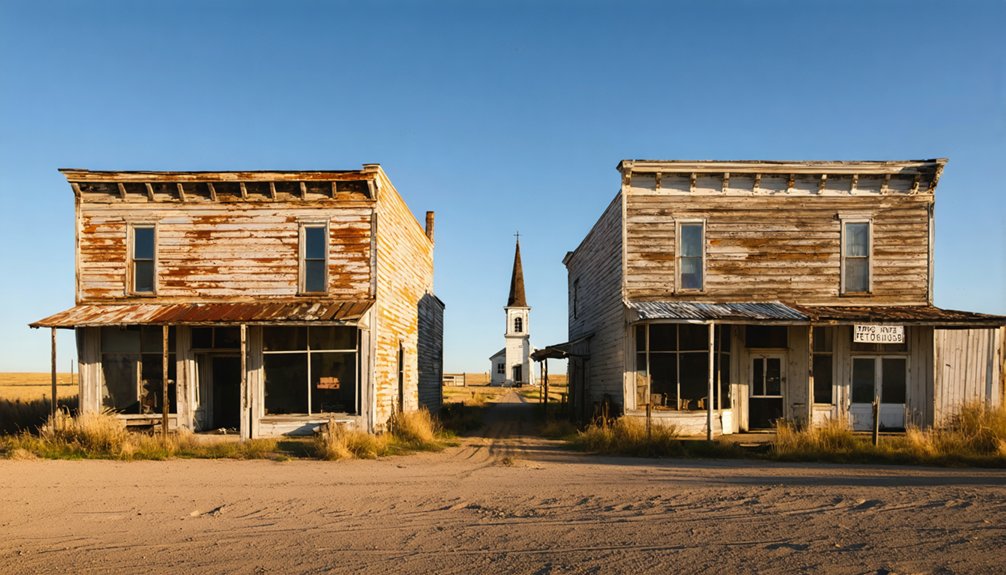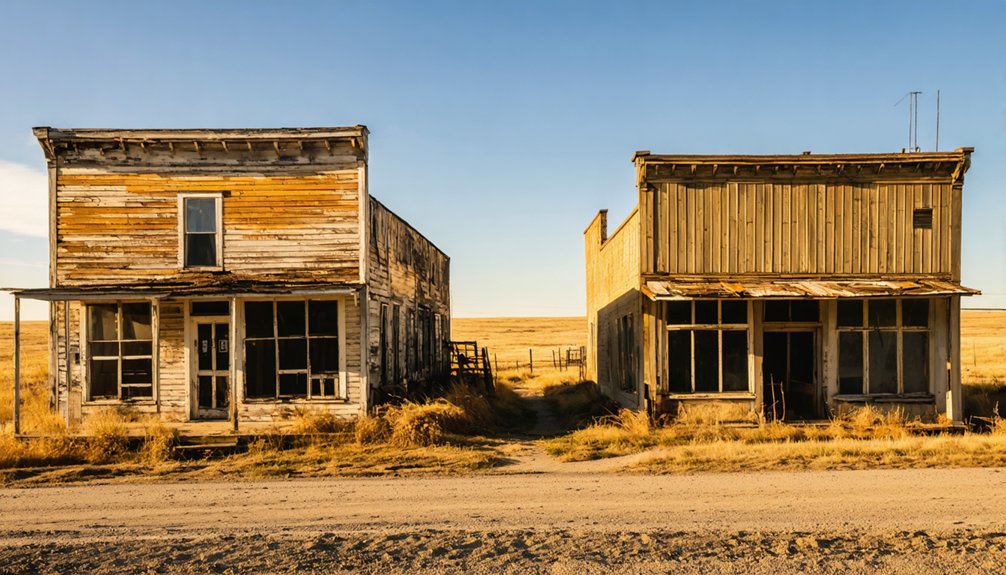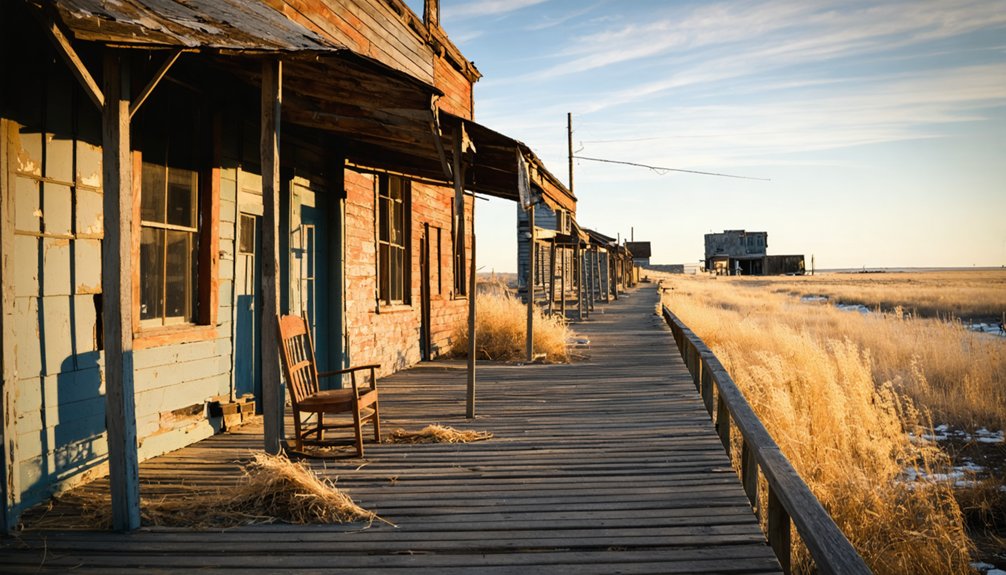You won’t find any physical traces of American City today, though it was once a bustling Black Hills gold rush settlement in the 1870s. Unlike other ghost towns in South Dakota that still show remnants of their mining past, American City vanished completely after catastrophic flooding wiped out all its structures and mining equipment. This unique ghost town’s exact location remains a mystery, though its story captures the dramatic rise and fall of frontier boomtowns.
Key Takeaways
- American City was a Black Hills mining boomtown that emerged during the 1870s gold rush near French Creek.
- Unlike other ghost towns, American City was completely destroyed by flooding, leaving no physical traces of its existence.
- The town’s exact location remains unknown today, making it unique among South Dakota’s ghost towns.
- American City declined during the Great Depression as residents left seeking better economic opportunities elsewhere.
- The area once featured typical boomtown establishments including saloons, mining operations, and makeshift housing for prospectors.
The Birth of a Mining Settlement
When Lieutenant Colonel George Armstrong Custer‘s 1874 expedition confirmed gold deposits near French Creek in the Black Hills, it set off a chain reaction that would transform the region.
Despite treaty restrictions with the Sioux, you’d have found thousands of determined prospectors flooding the area by 1875, including the bold Gordon Party who built fortifications and established early mining claims.
In defiance of Sioux treaties, waves of ambitious prospectors pushed into the Black Hills, risking everything for gold’s promise.
The rush to extract placer gold from streams quickly evolved into more sophisticated mining techniques as prospectors traced the precious metal to its source in underground quartz veins. The Homestake Mine became the region’s most productive operation, generating a remarkable tenth of global gold production over its lifetime.
The first permanent settler, Fred J. Cross, established a homestead in Buckeye Gulch in 1877, marking the beginning of what would later become Keystone.
As miners staked their claims, you would’ve witnessed rapid community formation around rich deposits, with settlements sprouting essential services like saloons and basic lodging.
Gold Rush Glory Days
As the Black Hills gold rush reached its pinnacle in the late 1870s, you’d have witnessed an extraordinary period of wealth creation centered around the legendary Homestake Mine. Your chances of striking it rich through gold prospecting would’ve increased dramatically near Lead, where the richest gold vein in U.S. history yielded over 40 million ounces. The rapid influx of miners led to the establishment of major boomtowns like Deadwood.
You’d have found yourself amid the tension between mining legislation and treaty rights, as thousands of fortune seekers defied the Fort Laramie Treaty of 1868. Despite the legal conflicts with the Sioux tribes, the rush transformed from simple panning operations to industrial-scale mining. George Hearst’s investors paid $70,000 to acquire the mine, which would prove to be an incredibly profitable decision.
The Homestake’s innovative extraction methods, using mercury amalgamation and gravity concentration, revolutionized how you’d mine gold, while producing nearly 10% of the world’s gold supply over the next century.
Life in the Black Hills Boomtown
Though life in Black Hills boomtowns centered around mining, you’d have found these frontier communities teeming with diverse activities and characters. The community dynamics revolved around makeshift streets where saloons, dance halls, and gambling establishments drew both fortune seekers and settlers alike.
You’d have witnessed a mix of miners, merchants, and families trying to build lives amid the chaos. Living conditions weren’t easy – you might’ve found yourself in a tent or hastily built shack, dealing with contaminated water and minimal sanitation.
Social establishments like brothels and gambling halls dominated the “Bad Lands” districts, while churches and schools emerged later as towns stabilized. Law enforcement remained sparse, with vigilante justice often stepping in to maintain order in these rugged frontier settlements. The summer of 1876 saw the population swell to over 5,000 people as prospectors flooded into the region. The discovery of gold in Custer’s 1874 expedition sparked this dramatic rush of settlers to the area.
The Slow Fade Into History
As you explore American City today, you’ll find the crumbling remnants of what was once a vibrant Black Hills mining community, where weathered buildings and rusted equipment stand as silent witnesses to its boom years.
Like many South Dakota ghost towns, American City’s decline accelerated during the Great Depression when residents left for larger towns and cities with better economic prospects. The search for these abandoned places requires patient hunting through historical records and terrain. For researchers and historians studying ghost towns like American City, disambiguation pages help distinguish between similarly named abandoned settlements across the American West.
Vanishing Buildings and Infrastructure
While many ghost towns fade quietly into South Dakota’s landscape, American City’s deterioration offers a stark example of how abandoned settlements physically vanish over time.
You’ll find severe structural decay throughout the remaining buildings, where harsh winters and summer storms have torn through unprotected walls and roofs. The town’s infrastructure collapse is particularly evident in its dangerous sinkholes, some reaching depths of 40 feet due to old mining operations below. Modern residents face similar challenges, with 158 homes impacted by emerging sinkholes in the Hideaway Hills neighborhood.
What’s left of American City’s original structures continues to crumble, with wooden buildings leaning precariously and masonry walls slowly returning to the earth. Over 500 concrete bunkers from a former military site now form the Vivos xPoint community, transforming the region’s abandoned landscape.
The freeze-thaw cycles you’ll witness each year further weaken the abandoned homes and shops, while incomplete utility projects stand as silent reminders of failed preservation attempts.
Population Exodus and Abandonment
During the late 1870s, American City’s population surged to nearly 3,000 residents, drawn by the promise of Black Hills gold and abundant mining opportunities.
As mining profits dwindled and harsh winters took their toll, you’d have witnessed a dramatic population decline that transformed this once-bustling community into a shell of its former self.
The community transformation unfolded through:
- Mass exodus of miners and business owners seeking work in more prosperous areas
- Closure of essential services including the general store and post office
- Abandonment of homes and commercial buildings as families relocated
- Dissolution of local government and social institutions
Preserved Remnants and Lost Stories

Unlike other South Dakota ghost towns where you can still explore physical remnants, American City’s structures and mining equipment were completely erased by flooding, leaving no trace of its existence.
You’ll find only stories passed down through local folklore about this mysterious settlement, as even its exact location remains unknown.
The town’s complete disappearance makes it unique among Black Hills ghost towns, where you typically can photograph crumbling buildings and abandoned mining equipment scattered across the landscape.
Crumbling Buildings Tell Tales
As you explore the weathered remains of American City, each crumbling structure tells a compelling story of South Dakota’s pioneer spirit. The ghostly whispers of the past echo through community buildings and abandoned homes, where architectural decay reveals the harsh realities of frontier life.
You’ll discover the authentic textures and materials that early settlers used to build their dreams, now standing as proof of their resourcefulness.
- Town halls and churches remain as silent sentinels, preserving the community’s social fabric.
- Former stores and banks showcase the town’s economic aspirations.
- Residential structures bear witness to families who once called this place home.
- Original furniture and artifacts within these buildings provide tangible connections to past daily life.
Mining Equipment Still Stands
The rugged mining equipment scattered across American City’s landscape stands as a tribute to South Dakota’s golden age of mineral extraction.
You’ll find remnants similar to those in nearby ghost towns like Maitland, where a 40-ton stamp mill once crushed precious ore, and Roubaix, where bull wheels still rust in the prairie winds.
These surviving pieces of mining machinery tell a compelling story of innovation and perseverance.
From broken hoists to tramway remains like those at Victoria Mine, each artifact represents the ingenuity early miners used to extract gold from the challenging Black Hills terrain.
While historical preservation efforts haven’t saved everything – fires and time have claimed many structures – the equipment that remains serves as a raw, authentic reminder of the region’s industrial heritage.
Fading Footprints in Time
While American City once thrived in Lawrence County, flooding has erased nearly every physical trace of its existence from the landscape.
Yet the ghostly echoes of this vanished town still resonate through oral histories and local legends, preserving forgotten dreams of the pioneering spirits who built their lives there.
- While you won’t find standing structures like those in nearby Spokane’s 1927 schoolhouse, American City’s story lives on through tales passed down through generations.
- The town’s legacy represents countless hopes and struggles of frontier families seeking fortune.
- Like many Black Hills communities, it fell victim to economic forces beyond its control.
- Though nature reclaimed the physical town, its cultural memory endures as a reflection of South Dakota’s bold mining era.
Visiting the Historic Site Today

Due to complete flooding that destroyed all physical traces of the original settlement, visiting American City’s historic site presents unique challenges for modern-day explorers.
You’ll find that the exact location remains unknown, making traditional ghost town tourism impossible at this spot. However, you can still experience the region’s historical significance by visiting nearby ghost towns in the Black Hills area.
While you can’t walk American City’s streets anymore, you’ll discover accessible alternatives like Rockerville and Okaton, where you can explore authentic mining ruins and artifacts.
These neighboring ghost towns offer marked trails, informational plaques, and sometimes even tourist amenities. Just remember to respect any posted regulations, stick to designated paths, and avoid disturbing historical structures when you’re exploring these remnants of South Dakota’s frontier past.
Frequently Asked Questions
What Indigenous Artifacts Have Been Found at the American City Site?
Over 100 artifacts show Indigenous peoples’ presence: you’ll find decorated pottery shards, stone arrowheads, bone tools for hide processing, and shell beads that demonstrate extensive trade networks throughout the Plains region.
Were There Any Famous Shootouts or Murders in American City?
You won’t find any confirmed shootout legends or unsolved murders from American City’s brief existence. Historical records don’t show evidence of violent incidents before flooding destroyed the town’s remains completely.
What Was the Average Gold Yield per Mine in American City?
You won’t find exact gold mining yield statistics for individual mines, but nearby Homestake’s 25,000+ ounces in 1999 suggests American City’s smaller operations likely produced in the low thousands of ounces annually.
Did Any Notable Historical Figures Own Property in American City?
Among thousands of recorded property transactions in early 1900s South Dakota, you won’t find notable residents owning property in this town – historical records show only local settlers and merchants held deeds here.
How Many Original Structures From American City Still Stand Today?
You won’t find any original buildings standing today – flooding completely destroyed the town’s structures. Despite any past preservation efforts, nature has reclaimed the entire site, leaving no visible remains.
References
- https://en.wikipedia.org/wiki/Deadwood
- https://www.sdpb.org/rural-life-and-history/2023-08-21/some-black-hills-ghost-towns-and-their-origins
- https://www.powderhouselodge.com/black-hills-attractions/fun-attractions/ghost-towns-of-western-south-dakota/
- https://www.youtube.com/watch?v=Glucs_Rq8Xs
- https://www.youtube.com/watch?v=_0WNYsFLSLA
- https://www.blackhillsbadlands.com/blog/post/old-west-legends-mines-ghost-towns-route-reimagined/
- https://en.wikipedia.org/wiki/List_of_ghost_towns_in_South_Dakota
- https://www.1880town.com
- https://b1027.com/south-dakota-has-an-abundance-of-ghost-towns/
- https://www.legendsofamerica.com/south-dakota-ghost-towns/



